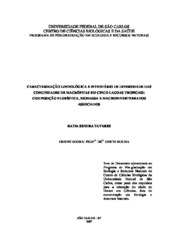Caracterização limnológica e inventário de diversidade das comunidades de macrófitas em cinco lagos tropicais: composição florística, biomassa e macroinvertebrados associados
Abstract
In the present study five tropical lakes located in Minas Gerais State were studied. The
methodology followed the scheme of rapid inventories of aquatic diversity as used in the
AquaRAP Program. Four lakes belonging to the Lacustrine System of the Middle Rio
Doce Valley (Carioca, Verde, Águas Claras e Almécega) were sampled in the rainy
(December 2003) and dry (May 2004). Tropeiros Lake located in the wetlands of Piumhi
River backwaters, a River formerly belonging to Rio Grande basin, but that had its course
changed to São Francisco basin, was sampled in October 2006, at the beginning of the rainy
season. The lakes of the Middle Rio Doce Valley had high water transparency (Secchi Disk
readings varying from 2.0 to 2.9m), low water conductivity (20 to 38 µScm-1), pH slightly
acid to slightly alkaline (6.2 8,4) and well oxygenated (3.9 to 7.8 mg/L). All lakes were
mesotrophic in December, 2003 (Total P varying from 17.38 to 21.62µg/L), but oligotrophic
in May, 2004, except Lake Carioca which was mesotrophic. Tropeiros Lake was found to be
mesotrophic at the sampling time. Total P varying from 23.2 a 45.4 µg/L) pH varying from
neutral to alkaline (7.0 to 9.2), moderate water conductivity (39.6 to 54.7 µScm-1) and oxygen
concentrations varying from low to moderate (1.5 a 6.1mg/L). The occurrence of a El-Niño
event in the years of 2002 and 2003 altered the regional pluviometric regime in the region of
the Valley of the Middle Rio Doce, MG, causing almost 40% reduction of the total annual
precipitation, with a marked decrease of the lakes water level. As a consequence, macrophyte
communities richness was low, with a total of 20 species of macrophytes only. On the other
hand a high species richness was observed in Tropeiros Lake, with a total of 28 species
registered. Among the studied lakes in the Middle Rio Doce Valley no relationship was found
between the biomass of macrophytes per unity area and the size of the lakes nor between the
amount of biomass and the trophic state of the lakes. In all five lakes studied the
macroinvertebrates communities associated with macrophytes were mainly constituted by
Chironomidae (Diptera) a pattern found in freshwaters world wide. A linear positive
relationship was found between the macrophyte biomass and the associated
macroinvertebrates biomass in Tropeiros Lake. Tropeiros Lake, although inventoried once
had a higher macrophyte taxa richness, higher macrophyte biomass and higher associated
macroinvertebrates biomass, probably representing a hot-spot of diversity for both,
macrophytes and associated macroinvertebrates communities.
